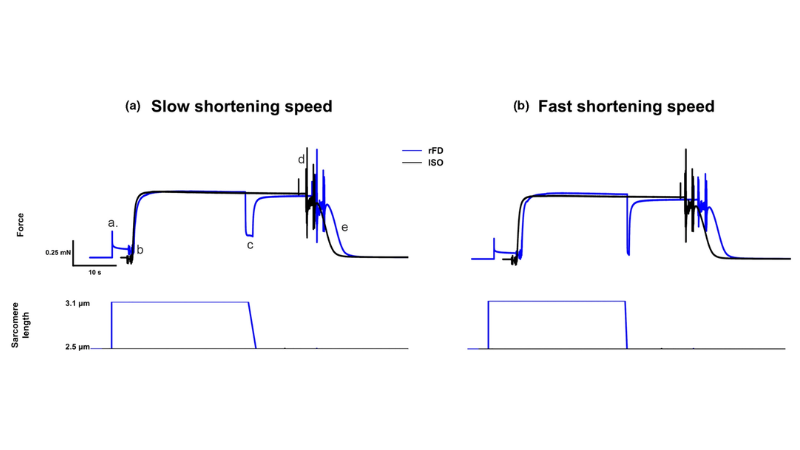Biomechanics is a fundamental process that involves the generation of force by muscle fibers. Research into these principles of mechanical properties in relation to biological systems is incredibly exciting. The following publication review showcases recent studies that utilize equipment from Aurora Scientific to make advances in the field of biomechanics.
Featured image (©Mashouri et al. (2021), licensed under CC BY), showcases force tracings for slow and fast active shortening conditions in relation to residual force depression.
Effects of Shortening Velocity on the Stiffness to Force Ratio During Isometric Force Redevelopment Suggest Mechanisms of Residual Force Depression
This article by Jeong & Nishikawa (2023) explores the phenomenon of residual force depression, which refers to a reduction in steady-state isometric force following active shortening and force redevelopment. The study investigates the ratio of muscle stiffness (km) to isometric force (FISO) during the isometric force redevelopment period after active shortening at different velocities. Previous studies have measured this ratio at a single time point, while this study aims to measure it at varying times after the onset of isometric force redevelopment. The authors hypothesized that the ratio of km to FISO can provide insights into the mechanisms underlying residual force depression.
The study design involves muscles developing force isometrically, followed by shortening at different velocities and varying durations of isometric force redevelopment. The authors used our 300B Dual-Mode Lever to conduct these measurements on mouse soleus muscles. In summary, the study found that the stiffness to force ratio during isometric force redevelopment is influenced by the velocity of active shortening. While weakly-bound cross bridges may contribute to the increased stiffness, other mechanisms such as the recovery of actin distortion or the involvement of titin as a tunable elastic element should also be considered. These findings contribute to a better understanding of the mechanisms underlying residual force depression.
An Increase in Force After Stretch of Diaphragm Fibers and Myofibrils is Accompanied by an Increase in Sarcomere Length Non-Uniformities and Ca2+ Sensitivity
This article by Contini et al. (2022) discusses the phenomenon of residual force enhancement (RFE) in skeletal muscles, which refers to the increase and stabilization of force when a muscle fiber is stretched while activated. The study highlights that RFE is not observed in cardiac muscles. The presence of RFE in skeletal muscles is attributed to a combination of static tension and sarcomere length nonuniformities during activation and stretch. The static tension is associated with an increase in the stiffness of the protein titin. The article also notes the lack of studies investigating RFE in the diaphragm muscle, which has unique characteristics due to its role as a respiratory muscle.
The study conducted experiments using intact living fibers and isolated myofibrils from mice to evaluate the presence and mechanism of RFE in the diaphragm. The authors prepared the muscle samples using our 801C: Small Intact Muscle Apparatus, 322C High -Speed Length Controller, and 405A Force Transducer. They stimulated the muscle fibers using our 701C Electrical Simulator, and analyzed the resulting data using the 600A Real-Time Muscle Data Acquisition and Analysis System. The authors observed RFE in the diaphragm, accompanied by increased sarcomere length nonuniformities and myofibrillar calcium sensitivity. They were able to then understand how sarcomere length nonuniformities and increased titin stiffness in myofibrils can lead to RFE by building a model that was able to reproduce the experimental observations.
Modifiability of Residual Force Depression in Single Muscle Fibers Following Uphill and Downhill Training in Rats
This article by Mashouri et al. (2021) examines residual force depression (rFD), a decrease in force after muscle shortening. The study investigates the modifiability of rFD at the single muscle fiber level and its relationship with fiber type and training. Previous research suggests that rFD may be influenced by the amount of work performed during shortening. Fiber type has shown some effect on rFD, but the results are inconclusive. Training studies have not found consistent modifications to rFD at the whole muscle level. The study aims to determine if rFD can be modified through uphill and downhill training in rats.
The authors took rats and subjected them to 4 weeks of uphill or downhill running, after which their extensor digitorum longus (EDL) and soleus (SOL) muscles were examined. Using our 403A Force Transducer and 322C High -Speed Length Controller the sarcomere length of the single fibers were set using our 901D High Speed video Sarcomere Length system. The results show that rFD was present in both muscles, with no changes observed after training. The EDL muscle exhibited greater rFD and stiffness depression compared to the SOL muscle. These findings suggest that rFD is an intrinsic property of single muscle fibers that is not modifiable by training.




